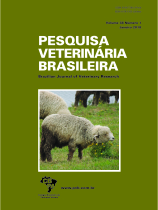 |
|
|
|
Year 2018 - Volume 38, Number 1
|

|
Detection of bluetongue virus in Brazilian cervids in São Paulo state, 38(1):137-142
|
ABSTRACT.- Kawanami A.E., Oliveira J.P., Arenales A., Crossley B., Woods L.W., Duarte J.M.B. & Werther K. 2018. Detection of bluetongue virus in Brazilian cervids in São Paulo state. [Detecção de vírus da língua azul em cervídeos brasileiros no estado de São Paulo.] Pesquisa Veterinária Brasileira 38(1):137-142. Departamento de Patologia Veterinária, Universidade Estadual Paulista “Júlio de Mesquita Filho”, Faculdade de Ciências Agrárias e Veterinárias, Via de acesso Prof. Paulo Donato Castellane, Jaboticabal, SP 14884-900, Brazil. E-mail: aline.kawanami@gmail.com
Viral hemorrhagic diseases in cervids occur worldwide and include epizootic hemorrhagic disease (EHD), bluetongue (BT), and adenoviral hemorrhagic disease (AHD). Since gross lesions in all three hemorrhagic diseases are identical (hemorrhagic enteropathy, pulmonary edema, systemic petechial and suffusion hemorrhages), it is necessary to use accurate techniques for a definitive etiologic diagnosis. Archival material (paraffin blocks) at the Department of Veterinary Pathology of FCAV – Unesp was reviewed for lesions of hemorrhagic disease and 42 captive and free-living Brazilian deer were selected to include in this study. Paraffin-embedded tissues were evaluated using immunohistochemistry and tested negative for adenovirus. Using real time RT-PCR, EHD virus was not detected in paraffin-embedded tissues in any of the cases evaluated. The same technique was used for detection of BT virus and seven positive animals (16,66%) were confirmed after agarose 4% gel electrophoresis and gene sequencing. The main macroscopic changes observed in the positive animals were hemorrhagic intestinal contents, reddish mucous membrane of the gastrointestinal tract, ulcers on tongue and petechiae in various organs. Microscopic changes observed were lymphocytic inflammatory infiltrate in liver, kidney and lungs, hemorrhage, and congestion in various organs. All positive cases were from captive animals, three females (two young and one adult), and four young males. This study demonstrates that the bluetongue virus is involved in hemorrhagic disease outbreaks of deer in Brazil. |
| |
|
|
| |
|
 |